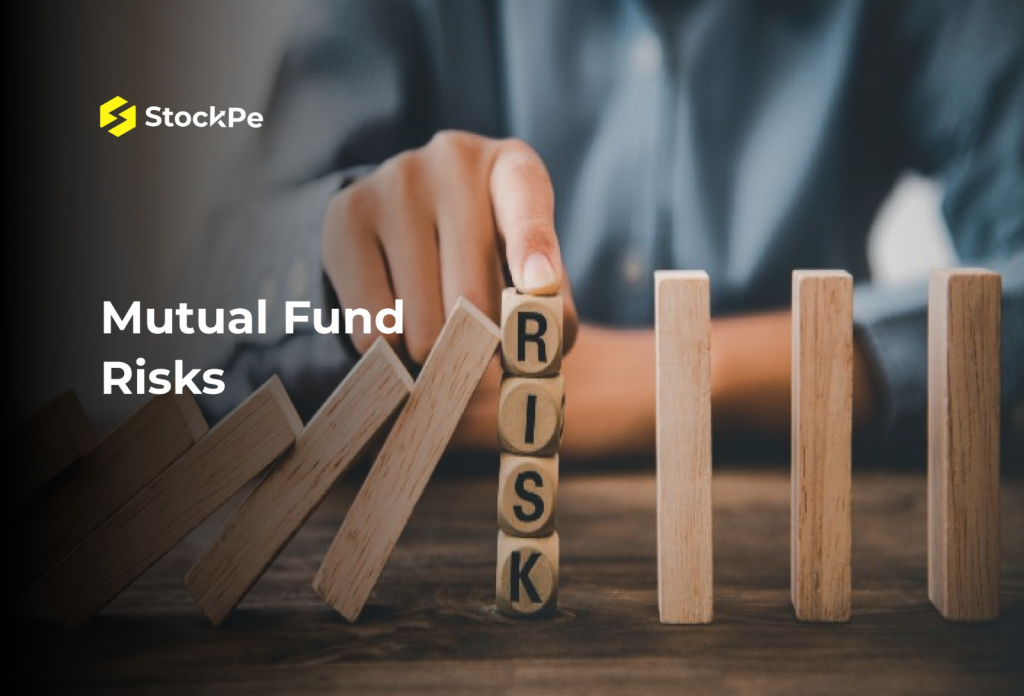Investment in the mutual fund is the pool of capital for use in purchasing securities, including stocks, bonds, government bonds, and money market instruments on behalf of the group. Professional fund managers spend the money contributed to a mutual fund scheme in securities like stocks and bonds to achieve the Scheme’s stated investment goal.

Common Types Of Risks
The following are some of the most common types of investment risk:
- Systemic Risk
Mutual funds are susceptible to a type of risk known as systematic risk, which is widespread and difficult to mitigate. A government pronouncement or rule, for instance, could affect your portfolio.
- Unpredictable Risk
Unsystematic risk, also known as specific risk, is a unique threat to a single asset. A company-specific example would be a fire that comes out unexpectedly or a strike by the employees.
Types Of Risk In Mutual Funds
There are various types of risk in mutual funds:
- Standard Risk Factors
Mutual fund schemes do not provide a surety of profit. Mutual fund units are subject to investment risks associated with trading activity, settlement, liquidity, default, and probable capital loss.
It may be influenced by factors affecting capital and money markets in general, including but not limited to changes in interest rates, currency exchange rates, Government policies, taxation, political, economic, or other developments, and increased volatility in the stock exchange and bond markets. Any Mutual Fund Scheme’s historical performance does not indicate its future results.
b. Specific Risk Factors
- Risks Associated With Investments In Equities
- Risk of losing money:
Your initial investment and any gains you make could be lost if you put your money in stocks or other equity-related securities.
- Price Risk:
Price risk is one of the types of risk in mutual funds. Shares of stock and other equity-related instruments are subject to daily price changes, known as “price risk.”
- Liquidity risk associated with mutual funds:
The liquidity of investments in equities may be constrained by trading volumes and settlement times, which is a liquidity risk for listed securities. Unexpected events have the potential to extend settlement times considerably. Liquidity risk is incurred due to the lengthy lock-in period.
- Event Risk:
The possibility is that a company’s stock price will drop due to an unforeseen incident.
- Risks Associated With Investment In Debt Securities And Money Market Instruments
Risks associated with debt securities include the potential for the issuer to default on principal and interest payments when they are due (Credit Risk) and price fluctuations due to interest rate sensitivity, the market’s view of the issuer’s creditworthiness, and general market liquidity (Market Risk).
- Interest Rate Risk
Generally speaking, a rise in interest rates will lower the market value of fixed-income instruments. Existing fixed-income security prices tend to decline as interest rates rise and to climb as interest rates fall. As a result, if the market interest rate goes up, the value of a scheme’s portfolio may go down, and vice versa if the rate goes down.
- Credit Risk
This is one of the Types of risk in mutual funds, which poses a danger to fixed-income security issuers, will fail to pay interest and principal as promised. In the event of a default, the Scheme’s Net Asset Value (NAV) may decrease by an amount equal to the shortfall. A security’s value might shift even without a default if investors anticipate a change in the issuer’s creditworthiness.
Credit risk is more significant for corporate bonds than government bonds. A bond with a better rating from a credit rating service is safer than one with a lower rating from the same service, and the same holds within the realm of corporate bonds.
- Spread Risk
Market factors affect the credit spread on corporate bonds. If credit spreads widen, the market value of the portfolio’s debt instruments could fall, and if they narrow, the deal could rise. Like fixed-rate securities, floating-rate assets may lose value if the spreads over the benchmark security or index widen.
- Liquidity Risk
The liquidity risk is the possibility that the security won’t be able to be sold for anywhere near its yield-to-maturity (YTM) value. Market liquidity is dynamic and changes over time. A bond’s liquidity might shift if the premium associated with its price, called the liquidity premium, fluctuates in response to market conditions.
- Counterparty Risk
This refers to the possibility that one party will fail to provide securities in exchange for payment received or to pay consideration in exchange for securities delivered, in whole or in part, or by the agreed specification. If the counterparty defaults, the fund may suffer a loss.
- Prepayment Risk
This occurs when the borrower pays off the loan before the due date. This could affect the mutual fund scheme’s yield and maturity. The average term of Asset-backed securities (ABS) decreases when interest rates fall because borrowers are more likely to refinance high-interest loans with money borrowed at a lower interest rate. With an increase in interest rates, borrowers still face prepayment risk when homeowners pay off mortgages or car loans when selling their vehicles.
- Reinvestment Risk
Since market interest rates at the time of a bond’s coupon payment or maturity may differ from the bond’s original coupon (the purchase yield of the security), investors in fixed-income instruments face reinvestment risk. Because of this, the actual gain realized may be lower than the projected yield.
Other Types of risks in Mutual funds
- Concentration risk
High exposure to a single asset class, industry, or topic is known as “concentration risk.” High exposure to stock schemes, for instance, indicates a high-risk investment strategy. There is a greater chance of financial loss when market conditions are unstable.
- Inflation Risk
The value of money declines as inflation rises. Any investment should be made to rise inflation. Investing in schemes that produce returns higher than inflation is a must. You are losing money on your assets if they do not earn a better rate of return than the market interest rate.
Final Words
In conclusion, investors who desire safe and successful financial outcomes from their mutual fund investments must understand potential dangers. Market risk is associated with investing in stocks, while interest rate risk affects bond funds.
Credit risk is the danger that bond issuers may default, while liquidity risk is the risk in which investors redeem an investment without incurring. Successfully managing the complex environment of mutual fund risks requires a high level of diligence and knowledge.
FAQs
- To what extent do mutual funds face market risk?
A fund’s investments are vulnerable to a decline in value if the market experiences a fall.
- What is the definition of interest rate risk?
Interest rate risk is the potential for a negative effect on the yield and value of bond-heavy mutual funds due to fluctuations in interest rates.
- In what ways are mutual funds exposed to credit risk?
The potential for bond issuers to fail on payments is the focus of credit risk, which can harm the value and returns of a fund.
- To what extent do mutual funds face liquidity risk?
A fund’s exposure to liquidity risk increases if the underlying assets are not readily convertible into cash in the event of a redemption request.
- How might financial backers mitigate this danger?
Mutual fund risks can be reduced through diversification, investor education about the fund’s objectives, and close oversight.





